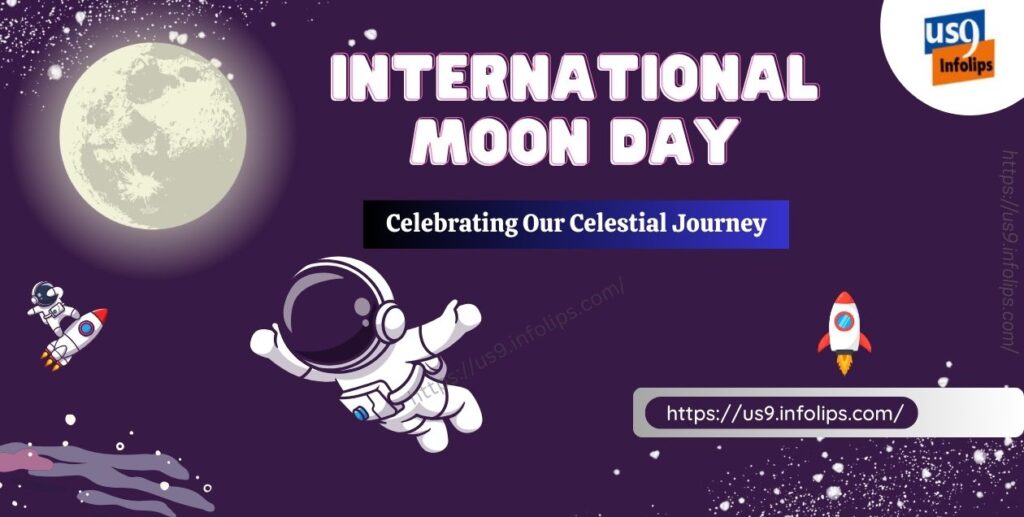International Moon Day: Celebrating Our Celestial Journey and Future Explorations, Perfect Info.
International Moon Day: A Celestial Celebration
International Moon Day is a day to celebrate one of humanity’s most awe-inspiring achievements and to appreciate the wonders of the Moon itself.
Celebrated annually on July 20, this day commemorates the anniversary of the first human landing on the Moon in 1969. Let’s explore the significance, history, and ways to celebrate this remarkable day.
Table of Contents
1. Historical Significance
International Moon Day marks the anniversary of the Apollo 11 mission, when astronauts Neil Armstrong and Buzz Aldrin became the first humans to set foot on the Moon on July 20, 1969.
This monumental event is not just a triumph of technology but a testament to human curiosity and determination. It opened the door to new possibilities in space exploration and inspired generations to look beyond our planet.
2. Scientific Importance
The Moon has played a crucial role in advancing our understanding of the universe. Studying the Moon’s surface and composition has provided valuable insights into the history of our solar system.
It serves as a natural laboratory for scientists to explore geological processes and the impact of cosmic events. Moon missions have helped scientists learn more about Earth’s history and the origins of our planet.
3. Cultural Impact
The Moon has been a source of fascination and inspiration for cultures worldwide. It features prominently in folklore, mythology, and art. From ancient legends about lunar deities to modern literature and films, the Moon continues to captivate human imagination.
International Moon Day is an opportunity to reflect on the Moon’s influence on human culture and creativity.
4. Educational Opportunities
International Moon Day serves as an excellent platform for educational activities and initiatives. Schools and organizations often host workshops, lectures, and exhibitions to engage people of all ages in learning about lunar science and space exploration.
It is a chance to inspire the next generation of scientists, engineers, and explorers.
5. Technological Advancements
The quest to explore the Moon has driven significant technological innovations. From developing advanced spacecraft to creating life-support systems, the challenges of lunar exploration have pushed the boundaries of human ingenuity.
These advancements have had broader applications, benefiting various fields, including medicine, engineering, and environmental science.
6. Global Collaboration
The exploration of the Moon has fostered international cooperation and collaboration. Countries around the world have joined forces to share knowledge, resources, and expertise in pursuit of common goals.
International Moon Day celebrates this spirit of unity, highlighting the importance of working together to overcome challenges and achieve extraordinary feats.
7. Future Exploration Plans
The Moon remains a focal point for future space exploration. Countries and private companies are planning new missions to explore the lunar surface, establish permanent bases, and use the Moon as a stepping stone for missions to Mars and beyond.
International Moon Day offers a glimpse into these exciting future endeavors and the potential they hold for humanity.
8. Environmental Awareness
The Moon also plays a role in understanding and addressing environmental challenges on Earth. Studying lunar geology and resources can inform sustainable practices and resource management.
International Moon Day emphasizes the importance of responsible exploration and the need to protect both Earth and other celestial bodies for future generations.
9. Ways to Celebrate
There are many ways to celebrate International Moon Day. People can participate in stargazing events, watch documentaries about lunar exploration, or visit planetariums and science museums.
Educational institutions and organizations often host talks and activities, providing opportunities for everyone to learn and engage with lunar science and history.
Personal Reflection
Lastly, International Moon Day encourages personal reflection on humanity’s place in the universe. It is a time to ponder the achievements and challenges of space exploration and the enduring allure of the Moon. This day reminds us of the boundless possibilities that lie ahead as we continue to explore and learn from our celestial neighbor.
9 Facts About International Moon Day
- Historical Milestone:
International Moon Day is celebrated on July 20, commemorating the Apollo 11 mission when humans first landed on the Moon in 1969. - UN Recognition:
In 2021, the United Nations declared July 20 as International Moon Day to promote awareness of lunar exploration and its benefits to humanity. - Global Celebrations:
Countries around the world celebrate International Moon Day with events such as educational workshops, exhibitions, and stargazing parties. - Educational Focus:
The day emphasizes education and inspires young people to pursue careers in science, technology, engineering, and mathematics (STEM). - Cultural Appreciation:
International Moon Day acknowledges the Moon’s influence on various cultures, myths, and artistic expressions throughout history. - Lunar Science Promotion:
The day promotes scientific research related to the Moon, including geological studies and potential resource utilization. - Space Agency Participation:
Space agencies like NASA, ESA, and others participate by organizing special programs and activities to mark the occasion. - Public Engagement:
The day encourages public engagement with space exploration through social media campaigns, public talks, and interactive sessions. - Vision for the Future:
International Moon Day highlights future missions and the potential for establishing a sustainable human presence on the Moon.
9 Unknown Facts About International Moon Day
- Inception by the Moon Village Association:
The idea for International Moon Day originated from the Moon Village Association, a global organization dedicated to lunar exploration and development. - Connection to the Artemis Program:
The day supports the goals of the Artemis program, which aims to return humans to the Moon and establish a permanent presence by the late 2020s. - Lunar Heritage Sites:
International Moon Day advocates for the preservation of lunar heritage sites, such as the Apollo landing sites, as part of humanity’s shared heritage. - Inspiration for Art and Music:
Artists and musicians use International Moon Day as a source of inspiration, creating works that celebrate the Moon’s beauty and significance. - Community-Driven Events:
Many International Moon Day events are organized by local communities and amateur astronomers, highlighting grassroots interest in space exploration. - Global Collaboration Projects:
The day encourages global collaboration in lunar exploration, with initiatives like the Lunar Gateway and international research partnerships. - Focus on Sustainability:
International Moon Day promotes sustainable exploration practices to minimize the environmental impact of lunar missions. - Lunar Economy Discussions:
The day includes discussions on the potential for a lunar economy, including mining resources like helium-3 and water ice. - Virtual Celebrations:
During the COVID-19 pandemic, many International Moon Day events shifted online, allowing people worldwide to participate virtually.
9 Controversies About International Moon Day
- Resource Exploitation Concerns:
There are debates over the ethical implications of exploiting lunar resources and the potential impact on the Moon’s environment. - Space Law Ambiguities:
The lack of clear international regulations regarding lunar exploration and resource utilization has led to legal uncertainties and potential conflicts. - Cultural Appropriation Issues:
Some argue that the focus on lunar exploration overlooks the cultural significance of the Moon in indigenous and traditional belief systems. - Space Race Tensions:
The renewed interest in lunar exploration has reignited geopolitical tensions reminiscent of the original space race between the United States and the Soviet Union. - Environmental Impact Debates:
Concerns exist about the environmental impact of increased lunar missions and the potential for space debris accumulation. - Commercialization of Space:
The involvement of private companies in lunar exploration has sparked debates about the commercialization of space and the potential for monopolies. - Equity in Space Access:
Discussions about who has the right to access and benefit from lunar resources highlight issues of equity and fairness in space exploration. - Scientific Prioritization:
Some scientists argue that the focus on returning humans to the Moon may divert resources and attention from other important scientific missions. - Historical Revisionism:
There are controversies surrounding the narrative of the Apollo missions and the representation of historical events in educational and cultural contexts.
Conclusion
International Moon Day is more than just a celebration of the past; it is a call to explore, understand, and appreciate our closest celestial neighbor. As we continue to dream about and plan for future lunar missions.
This day reminds us of the power of human ingenuity, the importance of international collaboration, and the endless possibilities that lie beyond our world. By recognizing the Moon’s significance in science, culture, and technology, we honor our shared history and inspire future generations to reach for the stars.
FAQs
Q.1: What is International Moon Day?
A: International Moon Day is celebrated on July 20 to commemorate the Apollo 11 Moon landing and promote lunar exploration and education.
Q.2: Why is International Moon Day important?
A: The day highlights the achievements in space exploration, encourages scientific research, and fosters global collaboration in exploring the Moon.
Q.3: How is International Moon Day celebrated?
A: It is celebrated with educational events, stargazing activities, lectures, and discussions about lunar science and future missions.
Q.4: Who initiated International Moon Day?
A: The Moon Village Association first proposed the idea, and it was later recognized by the United Nations in 2021.
Q.5: What are the goals of International Moon Day?
A: The goals include promoting awareness of lunar exploration, inspiring future generations, and encouraging sustainable space practices.
Q.6: How can I participate in International Moon Day?
A: You can participate by attending local events, joining virtual discussions, visiting planetariums, or engaging in social media campaigns.
Q.7: What are some future plans for lunar exploration?
A: Future plans include missions by various countries and private companies to establish lunar bases and conduct scientific research.
Q.8: What controversies are associated with International Moon Day?
A: Controversies include debates over lunar resource exploitation, space law ambiguities, and the commercialization of space.
Q.9: How does International Moon Day inspire future generations?
A: The day inspires future generations by promoting STEM education and highlighting the potential for new discoveries and innovations in space exploration.
Follow us for more captivating articles and stay connected to explore the world. Let’s embrace the power of communication and understanding.
Disclaimer: The views in this article are given with the help of information available on the net. Readers are encouraged to conduct their own research before making any decisions. The publisher disclaim any liability for any loss or damage caused directly or indirectly.

Related topics:
1. Perfect World Travel Guide
2. 9 Most Popular EV Cars in the USA
3. 9 Best Things About Apple TV 4K – Third Generation
4. Think before You Renew Amazon Prime
5. Jimmy Carter: A Great Legacy
6. Memorial Day: Honoring the Sacrifice, Celebrating Freedom
School Site :
For English grammar and lot more : Smart School Infolips
Marathi Poems: Marathi Rang












